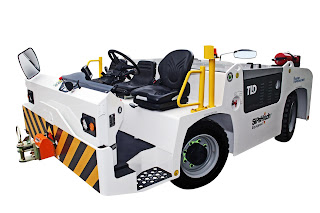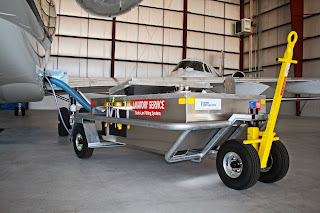Will the Future of Ground Support Equipment Be Electric?
To some degree, asking whether or not the future of ground support
equipment (GSE) will be electric is moot. Much of it already is.
Commuters are now used to electric vehicles (EV) ferrying people and
cargo around inside airports, and they’re becoming an increasingly
common feature of the airside workspace.
There are certainly a number of obvious advantages to GSE going electric, but the transition is not without challenges as well, particularly in the short-term. The question for the aviation industry is whether or not the transition to electric aircraft tugs and lav carts is worth the necessary modifications. Or, is the electrification of aviation an inevitability regardless of preference?
The Trend
As mentioned, there’s no question which direction the wind is blowing. Commercial and public transport across business sectors across the world are transitioning to EVs in earnest. And it’s happening fairly aggressively in many cases. Ten years ago, diesel vehicles made up 80% of the U.S.’s bus fleet. By 2015, it was 51%.
Similar initiatives in aviation are often just as aggressive. Air New Zealand has already become the first airline to conform to the EV 100 initiative to transition from internal combustion engines (ICE) to EVs for their entire light fleet. Likewise, LAX and Heathrow have shifted major portions of their fleet from ICE to electric, with many if not most other major airports now counting EVs among at least some of their fleet.
The Benefits
The benefits of a switch to EVs in any industry are pretty well known. Chief among those benefits are the positive environmental impact and the potential for considerable savings on fuel. As cramped as conditions can be and as precious as real estate is on the grounds of an airport, the potential to save a considerable amount of space by reducing the necessity for massive diesel tanks is likewise very attractive.
For ground crews that are already working around fuel-powered jets, replacing the quantity of fuel exhaust by switching out that diesel-powered aircraft tow tractor with an electric one is likely appealing. Working for an airside ground crew is also a fairly dangerous job, with an accident and injury rate considerably higher than the average occupation. Vehicle collisions are one of the most common, and the most dangerous, of those accidents. Remote-controlled EVs are also becoming increasingly commonplace, and getting crew personnel out from behind the wheel could prove a far less dangerous option.
The Drawbacks
While the fuel cost-cutting potential of EVs is impressive in the long run, EVs do tend to cost more than ICEs up front. Beyond which, transitioning to an EV fleet would also necessitate redesigning and retrofitting the infrastructure of the airport itself. It’s an investment a lot of airports are understandably wary about making. It’s not just the cost that’s a concern, either. There are also practical questions of the allocation of resources and cooperation.
Airside ground crews are employed by and beholden to different airlines, the airport, and sometimes third parties. That raises a number of questions about whether or not these different stakeholders can work together effectively to facilitate the infrastructure that would be necessary to run a fully electric airport. For now, the answer seems to be “Wait and see.”
About AERO Specialties
As part of their commitment to quality, innovation, and customer service, AERO Specialties ensures that all of their team members, even sales and support staff, are familiar with both the products and the aviation handling and maintenance industry. That attention to company-wide understanding of the business is representative of the ethos that has made AERO Specialties one of the most trusted names in GSE. They offer aircraft pushback vehicles and aircraft tugs, intercom and related audio equipment, deicing vehicles, lavatory carts, snack and drink vehicles, baggage and cargo handling solutions, hydraulic fluid services, an aircraft ground power unit line, towbars, aircraft lighting, and everything else necessary for the successful operation of an airside ground crew.
Optimize the efficiency of your ground crew’s airside operation with GSE from AERO Specialties at Aerospecialties.com
There are certainly a number of obvious advantages to GSE going electric, but the transition is not without challenges as well, particularly in the short-term. The question for the aviation industry is whether or not the transition to electric aircraft tugs and lav carts is worth the necessary modifications. Or, is the electrification of aviation an inevitability regardless of preference?
The Trend
As mentioned, there’s no question which direction the wind is blowing. Commercial and public transport across business sectors across the world are transitioning to EVs in earnest. And it’s happening fairly aggressively in many cases. Ten years ago, diesel vehicles made up 80% of the U.S.’s bus fleet. By 2015, it was 51%.
Similar initiatives in aviation are often just as aggressive. Air New Zealand has already become the first airline to conform to the EV 100 initiative to transition from internal combustion engines (ICE) to EVs for their entire light fleet. Likewise, LAX and Heathrow have shifted major portions of their fleet from ICE to electric, with many if not most other major airports now counting EVs among at least some of their fleet.
The Benefits
The benefits of a switch to EVs in any industry are pretty well known. Chief among those benefits are the positive environmental impact and the potential for considerable savings on fuel. As cramped as conditions can be and as precious as real estate is on the grounds of an airport, the potential to save a considerable amount of space by reducing the necessity for massive diesel tanks is likewise very attractive.
For ground crews that are already working around fuel-powered jets, replacing the quantity of fuel exhaust by switching out that diesel-powered aircraft tow tractor with an electric one is likely appealing. Working for an airside ground crew is also a fairly dangerous job, with an accident and injury rate considerably higher than the average occupation. Vehicle collisions are one of the most common, and the most dangerous, of those accidents. Remote-controlled EVs are also becoming increasingly commonplace, and getting crew personnel out from behind the wheel could prove a far less dangerous option.
The Drawbacks
While the fuel cost-cutting potential of EVs is impressive in the long run, EVs do tend to cost more than ICEs up front. Beyond which, transitioning to an EV fleet would also necessitate redesigning and retrofitting the infrastructure of the airport itself. It’s an investment a lot of airports are understandably wary about making. It’s not just the cost that’s a concern, either. There are also practical questions of the allocation of resources and cooperation.
Airside ground crews are employed by and beholden to different airlines, the airport, and sometimes third parties. That raises a number of questions about whether or not these different stakeholders can work together effectively to facilitate the infrastructure that would be necessary to run a fully electric airport. For now, the answer seems to be “Wait and see.”
About AERO Specialties
As part of their commitment to quality, innovation, and customer service, AERO Specialties ensures that all of their team members, even sales and support staff, are familiar with both the products and the aviation handling and maintenance industry. That attention to company-wide understanding of the business is representative of the ethos that has made AERO Specialties one of the most trusted names in GSE. They offer aircraft pushback vehicles and aircraft tugs, intercom and related audio equipment, deicing vehicles, lavatory carts, snack and drink vehicles, baggage and cargo handling solutions, hydraulic fluid services, an aircraft ground power unit line, towbars, aircraft lighting, and everything else necessary for the successful operation of an airside ground crew.
Optimize the efficiency of your ground crew’s airside operation with GSE from AERO Specialties at Aerospecialties.com




Comments
Post a Comment